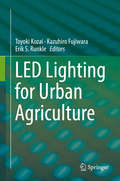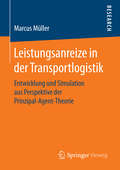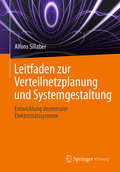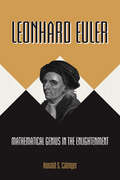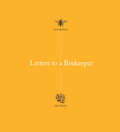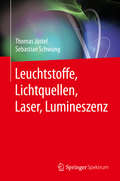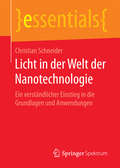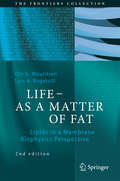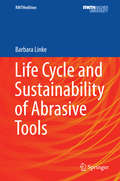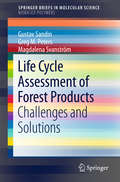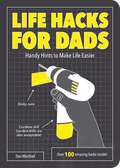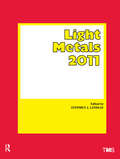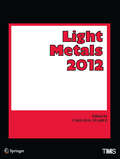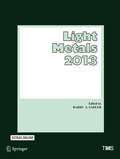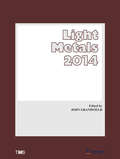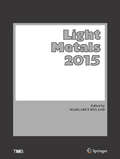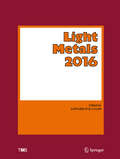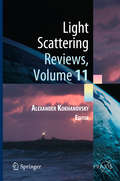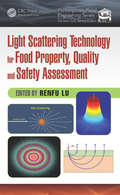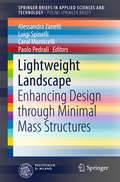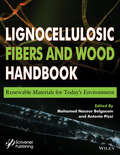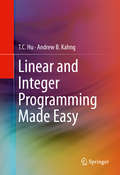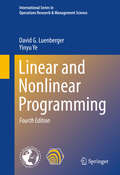- Table View
- List View
LED Lighting for Urban Agriculture
by Toyoki Kozai Kazuhiro Fujiwara Erik S. RunkleThis book focuses on light-emitting diode (LED) lighting, mainly for the commercial production of horticultural crops in plant factories and greenhouses with controlled environments, giving special attention to: 1) plant growth and development as affected by the light environment; and 2) business and technological opportunities and challenges with regard to LEDs. The book contains more than 30 chapters grouped into seven parts: 1) overview of controlled-environment agriculture and its significance; 2) the effects of ambient light on plant growth and development; 3) optical and physiological characteristics of plant leaves and canopies; 4) greenhouse crop production with supplemental LED lighting; 5) effects of light quality on plant physiology and morphology; 6) current status of commercial plant factories under LED lighting; and 7) basics of LEDs and LED lighting for plant cultivation. LED lighting for urban agriculture in the forthcoming decades will not be just an advanced form of current urban agriculture. It will be largely based on two fields: One is a new paradigm and rapidly advancing concepts, global technologies for LEDs, information and communication technology, renewable energy, and related expertise and their methodologies; the other is basic science and technology that should not change for the next several decades. Consideration should be given now to future urban agriculture based on those two fields. The tremendous potentials of LED lighting for urban agriculture are stimulating many people in various fields including researchers, businesspeople, policy makers, educators, students, community developers, architects, designers, and entrepreneurs. Readers of this book will understand the principle, concept, design, operation, social roles, pros and cons, costs and benefits of LED lighting for urban agriculture, and its possibilities and challenges for solving local as well as global agricultural, environmental, and social issues.
Leistungsanreize in der Transportlogistik: Entwicklung und Simulation aus Perspektive der Prinzipal-Agent-Theorie
by Marcus MüllerMarcus Müller beschreibt und erläutert Zielkonflikte zwischen Bauleitung und Baugeräteführer und stellt ein Modell auf, das Prognosen zur Wirkung von Anreizsystemen treffen kann. Aus der Theorie und Anwendungsdomäne leitet der Autor Anforderungen ab, um die Frage nach der Gestaltung von Anreizsystemen zu beantworten, mit dem Ziel, Transportleistungen zu erhöhen. Seine Studie bestätigt die experimentellen bzw. empirischen Erkenntnisse zur Wirkung von Anreizsystemen und zeigt, dass diese auch für Transportlogistiksysteme im Tiefbau gelten. Aus den Erkenntnissen der Simulation leitet der Autor Empfehlungen für die Gestaltung von Entlohnungsmodellen ab.
Leitfaden zur Verteilnetzplanung und Systemgestaltung: Entwicklung dezentraler Elektrizitätssysteme
by Alfons SillaberDieses Buch beleuchtet das aktuelle Umfeld des Planers, Verantwortlichen und Betriebsführers sowie deren Gestaltungsmöglichkeiten. Vor dem Hintergrund der Herausforderung der Entwicklung wirtschaftlicher und zuverlässiger dezentraler Elektrizitätssysteme sind auf Basis der theoretischen Grundlagen die praxisrelevanten Anwendungen gezeigt. Eine klare Struktur und bewusst knappe Einheiten zeichnen das Buch aus. Die wichtigen Elemente der Systementwicklung sind darin herausgearbeitet. Ein umfassendes Portfolio an Planungsmethoden ist in Theorie und Praxis vorgestellt. Damit kann es zum Begleiter vom Studium bis in den Beruf werden.
Leonhard Euler: Mathematical Genius in the Enlightenment
by Ronald S. CalingerThis is the first full-scale biography of Leonhard Euler (1707–83), one of the greatest mathematicians and theoretical physicists of all time. In this comprehensive and authoritative account, Ronald Calinger connects the story of Euler's eventful life to the astonishing achievements that place him in the company of Archimedes, Newton, and Gauss. Drawing chiefly on Euler’s massive published works and correspondence, which fill more than eighty volumes so far, this biography sets Euler’s work in its multilayered context—personal, intellectual, institutional, political, cultural, religious, and social. It is a story of nearly incessant accomplishment, from Euler’s fundamental contributions to almost every area of pure and applied mathematics—especially calculus, number theory, notation, optics, and celestial, rational, and fluid mechanics—to his advancements in shipbuilding, telescopes, ballistics, cartography, chronology, and music theory.The narrative takes the reader from Euler’s childhood and education in Basel through his first period in St. Petersburg, 1727–41, where he gained a European reputation by solving the Basel problem and systematically developing analytical mechanics. Invited to Berlin by Frederick II, Euler published his famous Introductio in analysin infinitorum, devised continuum mechanics, and proposed a pulse theory of light. Returning to St. Petersburg in 1766, he created the analytical calculus of variations, developed the most precise lunar theory of the time that supported Newton’s dynamics, and published the best-selling Letters to a German Princess—all despite eye problems that ended in near-total blindness. In telling the remarkable story of Euler and how his achievements brought pan-European distinction to the Petersburg and Berlin academies of sciences, the book also demonstrates with new depth and detail the central role of mathematics in the Enlightenment.
Letters to a Beekeeper
by Alys Fowler Steve BenbowThis the story of how, over the course of a year, Alys, the Guardian gardening writer, learns how to keep bees; and Steve, the urban beekeeper, learns how to plant a pollinator-friendly garden.Part beautifully designed coffee-table book, part manifesto, this collection of engaging letters, emails, texts, recipes, notes and glorious photos creates a record of the trials, tribulations, rewards and joys of working with, rather than against, nature. And along the way, you will pick up a wealth of advice, tips and ideas for growing food and keeping pollinators well fed. Letters to a Beekeeper is for lazy gardeners, novice beekeepers and everyone in between. It is the best rule-breaking, wildlife-friendly, guerilla, urban gardening, insect-identifying, honey-tasting, wax-dripping, epistolary how-to book you could ever hope to own.
Leuchtstoffe, Lichtquellen, Laser, Lumineszenz
by Thomas Jüstel Sebastian SchwungDas vorliegende Buch dient als Nachschlagewerk wichtiger Begriffe und Materialien, die im Bereich der Lumineszenz sowie der Lampen-, Laser-, Leuchtstoff- und Lichttechnik von Bedeutung sind. Es liefert somit Antworten und Daten zu Fragestellungen im Zusammenhang mit dem Fachgebiet der Photonik.
Licht in der Welt der Nanotechnologie: Ein verständlicher Einstieg in die Grundlagen und Anwendungen (essentials)
by Christian SchneiderDieses essential gibt einen Überblick über die der Nanotechnologie zugrunde liegenden physikalischen Prinzipien, die es heute ermöglichen, mikroskopische Effekte technologisch zu nutzen. Es werden Methoden vorgestellt, welche die Herstellung von Nanostrukturen mit höchster Präzision erlauben. Im letzten Kapitel gibt der Autor einen Überblick über spannende technologische Anwendungen, angefangen vom Einsatz von auf Nanotechnologie basierenden Effekten bei Kirchenglasfenstern bis hin zu Solarzellen und CCD-Chips.
LIFE - AS A MATTER OF FAT: Lipids in a Membrane Biophysics Perspective (The Frontiers Collection)
by Ole G. Mouritsen Luis A. BagatolliThe present book gives a multi-disciplinary perspective on the physics of life and the particular role played by lipids (fats) and the lipid-bilayer component of cell membranes. The emphasis is on the physical properties of lipid membranes seen as soft and molecularly structured interfaces. By combining and synthesizing insights obtained from a variety of recent studies, an attempt is made to clarify what membrane structure is and how it can be quantitatively described. Furthermore, it is shown how biological function mediated by membranes is controlled by lipid membrane structure and organization on length scales ranging from the size of the individual molecule, across molecular assemblies of proteins and lipid domains in the range of nanometers, to the size of whole cells. Applications of lipids in nanotechnology and biomedicine are also described.The first edition of the present book was published in 2005 when lipidomics was still very much an emerging science and lipids about to be recognized as being as important for life as proteins, sugars, and genes. This significantly expanded and revised edition takes into account the tremendous amount of knowledge gained over the past decade. In addition, the book now includes more tutorial material on the biochemistry of lipids and the principles of lipid self-assembly. The book is aimed at undergraduate students and young research workers within physics, chemistry, biochemistry, molecular biology, nutrition, as well as pharmaceutical and biomedical sciences.From the reviews of the first edition:"This is a highly interesting book and a pleasure to read. It represents a new and excellent pedagogical introduction to the field of lipids and the biophysics of biological membranes. I reckon that physicists and chemists as well as biologists will benefit from this approach to the field and Mouritsen shows a deep insight into the physical chemistry of lipids." (Göran Lindblom, Chemistry and Physics of Lipids 2005, vol. 135, page 105-106)"The book takes the reader on an exciting journey through the lipid world, and Mouritsen attracts the attention with a lively style of writing … . a comprehensive view of the ‘lipid sea’ can be easily achieved, gaining the right perspectives for envisaging future developments in the nascent field of lipidomics." (Carla Ferreri, ChemBioChem, Vol. 6 (8), 2005)
Life Cycle and Sustainability of Abrasive Tools (RWTHedition)
by BARBARA LINKEThis monograph focuses on abrasive tools for grinding, polishing, honing, and lapping operations. The book describes the life cycle of abrasive tools from raw material processing of abrasive grits and bonding, manufacturing of monolithic or multi-layered tools, tool use to tool end-of-life. Moreover, this work highlights sustainability challenges including economic, environmental, social and technological aspects. The target audience primarily comprises research and industry experts in the field of manufacturing, but the book may also be beneficial for graduate students.
Life Cycle Assessment of Forest Products: Challenges and Solutions (SpringerBriefs in Molecular Science)
by Gustav Sandin Greg M. Peters Magdalena SvanströmThis brief contains information on the reduction of environmental impact and explains how it is a key driver for the R&D of new forest products. The authors, experts in the field, describe how Life Cycle Assessment (LCA) is used to assess the environmental impact of such products, e.g. in order to guide R&D or attract investments. The authors describe the main challenges of carrying out LCAs on forest products, make recommendations for managing these challenges, and discuss future research needs. LCA case studies are used to illustrate the challenges, covering a variety of forest products: building components, biofuels, industrial chemicals, textile fibres and clothing. Described challenges include the planning of LCA studies (e.g.how can one use LCA in R&D?), the modelling of product systems (how can one handle multi-functionality and uncertainties related to waste handling and geographical location of future production?) and environmental impact (how can one assess water and land use impact, and the climate impact of biomass?).
Life Hacks for Dads: Handy Hints to Make Life Easier (Life Hacks Ser.)
by Dan MarshallLife Hacks for Dads is your handy guide to making your daily life that little bit easier. This fully illustrated manual covers everything from keeping your car door wonderfully dent-free to making sure your kids stay entertained, and much, much more.
Light Metals 2011 (The Minerals, Metals & Materials Series)
The Light Metals symposia are a key part of the TMS Annual Meeting & Exhibition, presenting the most recent developments, discoveries, and practices in primary aluminum science and technology. Publishing the proceedings from these important symposia, the Light Metals volume has become the definitive reference in the field of aluminum production and related light metal technologies. Light Metals 2011 offers a mix of the latest scientific research findings and applied technology, covering alumina and bauxite, aluminum reduction technology, aluminum rolling, cast shop for aluminum production, electrode technology, and furnace efficiency.
Light Metals 2012 (The Minerals, Metals & Materials Series)
An update of the definitive annual reference source in the field of aluminum production and related light metals technologies, a great mix of materials science and practical, applied technology surrounding aluminum, bauxite, aluminum reduction, rolling, casting, and production.
Light Metals 2014 (The Minerals, Metals & Materials Series)
The Light Metals symposia are a key part of the TMS Annual Meeting & Exhibition, presenting the most recent developments, discoveries, and practices in primary aluminum science and technology. Publishing the proceedings from these important symposia, the Light Metals volume has become the definitive reference in the field of aluminum production and related light metal technologies. The 2014 collection includes papers from the following symposia: •Alumina and Bauxite •Aluminum Alloys: Fabrication, Characterization and Applications •Aluminum Processing •Aluminum Reduction Technology •Cast Shop for Aluminum Production •Electrode Technology for Aluminum Production •Light-metal Matrix (Nano)-composites
Light Metals 2015 (The Minerals, Metals & Materials Series)
The Light Metals symposia are a key part of the TMS Annual Meeting & Exhibition, presenting the most recent developments, discoveries, and practices in primary aluminum science and technology. Publishing the proceedings from these important symposia, the Light Metals volume has become the definitive reference in the field of aluminum production and related light metal technologies. The 2015 collection includes papers from the following symposia: 1.Alumina and Bauxite 2.Aluminum Alloys: Fabrication, Characterization and Applications 3.Aluminum Processing 4.Aluminum Reduction Technology 5.Cast Shop for Aluminum Production 6.Electrode Technology for Aluminum Production 7.Strip Casting of Light Metals
Light Metals 2016 (The Minerals, Metals & Materials Series)
The Light Metals symposia are a key part of the TMS Annual Meeting & Exhibition, presenting the most recent developments, discoveries, and practices in primary aluminum science and technology. Publishing the proceedings from these important symposia, the Light Metals volume has become the definitive reference in the field of aluminum production and related light metal technologies. The 2016 collection includes papers from the following symposia: 1.Alumina and Bauxite 2.Aluminum Alloys, Processing, and Characterization 3.Aluminum Reduction Technology 4.Cast Shop Technology 5.Electrode Technology 6.Strip Casting
Light Scattering Reviews, Volume 11: Light Scattering and Radiative Transfer (Springer Praxis Books)
by Alexander KokhanovskyThis is the eleventh volume in the series Light Scattering Reviews, devoted to current knowledge of light scattering problems and both experimental and theoretical research techniques related to their solution. The focus of this volume is to describe modern advances in radiative transfer and light scattering optics. This book brings together the most recent studies on light radiative transfer in the terrestrial atmosphere, while also reviewing environmental polarimetry. The book is divided into nine chapters: • the first four chapters review recent advances in modern radiative transfer theory and provide detailed descriptions of radiative transfer codes (e.g., DISORT and CRTM). Approximate solutions of integro-differential radiative transfer equations for turbid media with different shapes (spheres, cylinders, planeparallel layers) are detailed; • chapters 5 to 8 focus on studies of light scattering by single particles and radially inhomogeneous media; • the final chapter discusses the environmental polarimetry of man-made objects.
Light Scattering Technology for Food Property, Quality and Safety Assessment (Contemporary Food Engineering)
by Renfu LuLight Scattering Technology for Food Property, Quality and Safety Assessment discusses the development and application of various light scattering techniques for measuring the structural and rheological properties of food, evaluating composition and quality attributes, and detecting pathogens in food. The first four chapters cover basic concepts, principles, theories, and modeling of light transfer in food and biological materials. Chapters 5 and 6 describe parameter estimation methods and basic techniques for determining optical absorption and scattering properties of food products. Chapter 7 discusses the spatially-resolved measurement technique for determining the optical properties of food and biological materials, whereas Chapter 8 focuses on the time-resolved spectroscopic technique for measuring optical properties and quality or maturity of horticultural products. Chapter 9 examines practical light scattering techniques for nondestructive quality assessment of fruits and vegetables. Chapter 10 presents the theory of light transfer in meat muscle and the measurement of optical properties for determining the postmortem condition and textural properties of muscle foods and meat analogs. Chapter 11 covers the applications of spatially-resolved light scattering techniques for assessing quality and safety of animal products. Chapter 12 looks into light scattering for milk and dairy processing. Chapter 13 examines the applications of dynamic light scattering for measuring the microstructure and rheological properties of food. Chapter 14 shows the applications of a biospeckle technique for assessing the quality and condition of fruits and vegetables. Chapter 15 provides a detailed description of Raman scattering spectroscopic and imaging techniques in food quality and safety assessment. Chapter 16, the final chapter, focuses on applications of light scattering techniques for the detection of food-borne pathogens.
Light Scattering Technology for Food Property, Quality and Safety Assessment (Contemporary Food Engineering)
by Renfu LuLight Scattering Technology for Food Property, Quality and Safety Assessment discusses the development and application of various light scattering techniques for measuring the structural and rheological properties of food, evaluating composition and quality attributes, and detecting pathogens in food. The first four chapters cover basic concepts, principles, theories, and modeling of light transfer in food and biological materials. Chapters 5 and 6 describe parameter estimation methods and basic techniques for determining optical absorption and scattering properties of food products. Chapter 7 discusses the spatially-resolved measurement technique for determining the optical properties of food and biological materials, whereas Chapter 8 focuses on the time-resolved spectroscopic technique for measuring optical properties and quality or maturity of horticultural products. Chapter 9 examines practical light scattering techniques for nondestructive quality assessment of fruits and vegetables. Chapter 10 presents the theory of light transfer in meat muscle and the measurement of optical properties for determining the postmortem condition and textural properties of muscle foods and meat analogs. Chapter 11 covers the applications of spatially-resolved light scattering techniques for assessing quality and safety of animal products. Chapter 12 looks into light scattering for milk and dairy processing. Chapter 13 examines the applications of dynamic light scattering for measuring the microstructure and rheological properties of food. Chapter 14 shows the applications of a biospeckle technique for assessing the quality and condition of fruits and vegetables. Chapter 15 provides a detailed description of Raman scattering spectroscopic and imaging techniques in food quality and safety assessment. Chapter 16, the final chapter, focuses on applications of light scattering techniques for the detection of food-borne pathogens.
Lightweight Landscape: Enhancing Design through Minimal Mass Structures (SpringerBriefs in Applied Sciences and Technology)
by Alessandra Zanelli Luigi Spinelli Carol Monticelli Paolo PedraliThis book explains how lightweight materials and structures can be deployed in buildings to meet high environmental and aesthetic standards and emphasizes how the concept of lightness in building technology and design dovetails with the desire to enhance landscape. The first part of the book, on lightweight construction, aims to foster the use of membranes within the specific climatic context and in particular considers how lightweight materials and innovative technologies can enrich the quality of temporary spaces. The second part focuses exclusively on landscape, presenting novel approaches in the search for visual lightness and the quest to improve urban spaces. Particular attention is paid to the Italian experience, where the traditional appreciation of brick and stone has limited the scope for use of lightweight structures and membrane materials, often relegating them to a secondary or inappropriate role. The reader will come to appreciate how this attitude demeans a very advanced productive sector and neglects the ancient tradition of temporary architecture.
Lignocellulosic Fibers and Wood Handbook: Renewable Materials for Today's Environment
by Naceur Belgacem Antonio PizziThis book will focus on lignocellulosic fibres as a raw material for several applications. It will start with wood chemistry and morphology. Then, some fibre isolation processes will be given, before moving to composites, panel and paper manufacturing, characterization and aging.
Lignocellulosic Fibers and Wood Handbook: Renewable Materials for Today's Environment
by Antonio Pizzi Mohamed Naceur BelgacemThis book will focus on lignocellulosic fibres as a raw material for several applications. It will start with wood chemistry and morphology. Then, some fibre isolation processes will be given, before moving to composites, panel and paper manufacturing, characterization and aging.
Linear and Integer Programming Made Easy
by T. C. Hu Andrew B. KahngThis textbook provides concise coverage of the basics of linear and integer programming which, with megatrends toward optimization, machine learning, big data, etc., are becoming fundamental toolkits for data and information science and technology. The authors’ approach is accessible to students from almost all fields of engineering, including operations research, statistics, machine learning, control system design, scheduling, formal verification and computer vision. The presentations enables the basis for numerous approaches to solving hard combinatorial optimization problems through randomization and approximation. Readers will learn to cast various problems that may arise in their research as optimization problems, understand the cases where the optimization problem will be linear, choose appropriate solution methods and interpret results appropriately.
Linear and Nonlinear Programming (International Series in Operations Research & Management Science #228)
by David G. Luenberger Yinyu YeThis new edition covers the central concepts of practical optimization techniques, with an emphasis on methods that are both state-of-the-art and popular. One major insight is the connection between the purely analytical character of an optimization problem and the behavior of algorithms used to solve a problem. This was a major theme of the first edition of this book and the fourth edition expands and further illustrates this relationship. As in the earlier editions, the material in this fourth edition is organized into three separate parts. Part I is a self-contained introduction to linear programming. The presentation in this part is fairly conventional, covering the main elements of the underlying theory of linear programming, many of the most effective numerical algorithms, and many of its important special applications. Part II, which is independent of Part I, covers the theory of unconstrained optimization, including both derivations of the appropriate optimality conditions and an introduction to basic algorithms. This part of the book explores the general properties of algorithms and defines various notions of convergence. Part III extends the concepts developed in the second part to constrained optimization problems. Except for a few isolated sections, this part is also independent of Part I. It is possible to go directly into Parts II and III omitting Part I, and, in fact, the book has been used in this way in many universities.New to this edition is a chapter devoted to Conic Linear Programming, a powerful generalization of Linear Programming. Indeed, many conic structures are possible and useful in a variety of applications. It must be recognized, however, that conic linear programming is an advanced topic, requiring special study. Another important topic is an accelerated steepest descent method that exhibits superior convergence properties, and for this reason, has become quite popular. The proof of the convergence property for both standard and accelerated steepest descent methods are presented in Chapter 8. As in previous editions, end-of-chapter exercises appear for all chapters.From the reviews of the Third Edition:“… this very well-written book is a classic textbook in Optimization. It should be present in the bookcase of each student, researcher, and specialist from the host of disciplines from which practical optimization applications are drawn.” (Jean-Jacques Strodiot, Zentralblatt MATH, Vol. 1207, 2011)
